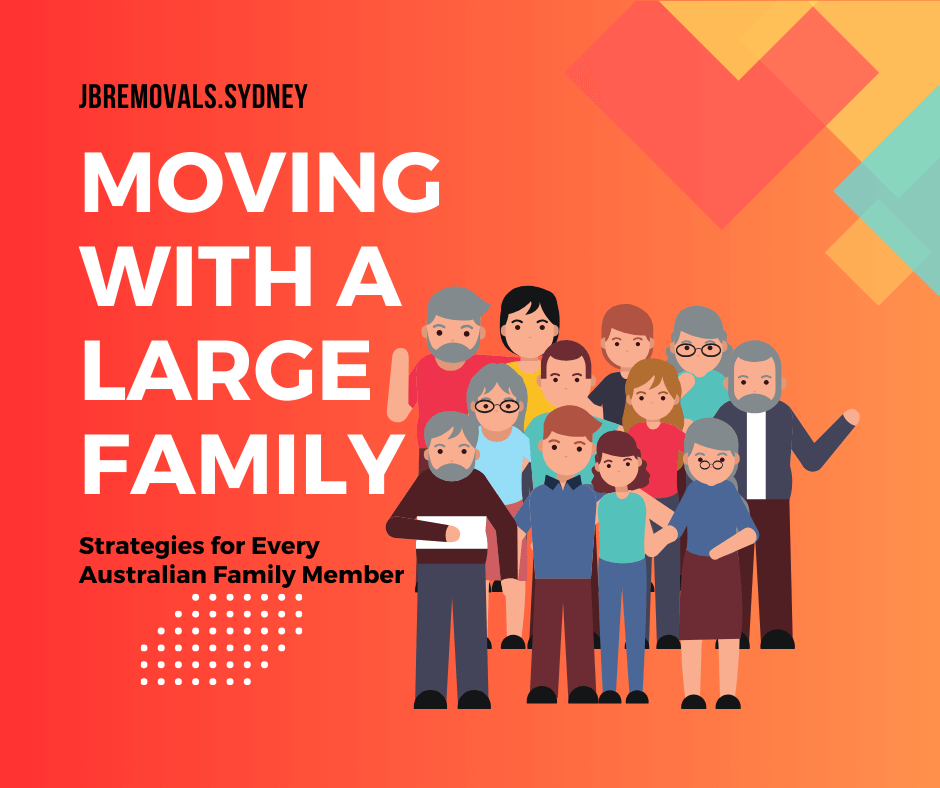


Moving with a large family can be both an exciting and challenging endeavour. Whether you’re relocating within your city or moving across the country, the logistics of coordinating the needs and preferences of every family member can be complex. In Australia, where families often span generations and have diverse requirements, strategic planning and communication are key to a successful move. Let’s delve into the strategies, historical context, frequently asked questions, and interesting facts related to moving with a large family to Australia.
Australia’s historical narrative is deeply entwined with the stories of its indigenous peoples, who have inhabited the land for tens of thousands of years. Indigenous Australians, with their diverse cultures, languages, and traditions, have cultivated a profound connection with the Australian landscape. Their enduring presence and custodianship over the land are a fundamental aspect of Australia’s historical context, shaping its identity and interactions with newcomers.
The 18th and 19th centuries saw a significant transformation of the Australian landscape due to European exploration and colonisation. European settlers arrived at Australian shores, bringing with them their culture, technology, and governance systems. The arrival of the First Fleet in 1788 marked the beginning of a new era for Australia, as a penal colony was established in New South Wales, fundamentally altering the social fabric and demographics of the continent.
Convicts, primarily from the United Kingdom, were forcibly transported to Australia as part of the penal system, serving their sentences in a harsh and unfamiliar environment. Their arrival, alongside free settlers and explorers, catalysed a complex process of cultural exchange and adaptation. Over time, this led to the emergence of a unique Australian identity that blended elements of both the old world and the new, as well as a distinct Australian accent and colloquial language.
In more recent decades, Australia has positioned itself as a destination for skilled migrants and individuals seeking a better quality of life. This shift has brought about a multicultural evolution, enriching the Australian social fabric with a mosaic of cultures, traditions, and cuisines. The country’s immigration policies have been structured to attract talent and contribute to its economic growth and cultural diversity. Consequently, major cities like Sydney, Melbourne, and Brisbane have become multicultural hubs, reflecting the global influences that have shaped modern Australia.
This historical context of migration, from the indigenous peoples’ enduring presence to the waves of European settlers and the contemporary influx of skilled migrants, has fostered a culture of movement and mobility within the country. Australians, with their diverse ancestry and immigrant roots, often embrace change and mobility as part of their national ethos, fostering a society that readily adapts to new challenges and experiences. The amalgamation of these historical influences is a testament to Australia’s resilience and dynamic identity as it continues to welcome and integrate people from around the world.
1. Communicate openly:
Effective communication is crucial. Discuss expectations, concerns, and preferences openly with all family members to ensure a smooth transition.
2. Plan together:
Involve everyone in the planning process, considering each person’s needs and priorities. Create a family moving plan collaboratively.
3. Assign responsibilities:
Delegate age-appropriate tasks to each family member to ensure an organised and efficient moving process.
4. Research the new location:
Familiarise the family with the new area, amenities, schools, healthcare facilities, and recreational activities to ease the transition.
5. Pack strategically:
Organise belongings efficiently, and involve the family in decluttering and packing activities. Label boxes for easy unpacking.
6. Maintain routines:
Stick to familiar routines to provide stability and comfort, especially for children and the elderly, during the moving process.
7. Support each other emotionally:
Moving can be emotionally challenging. Encourage open discussions about feelings and provide emotional support to one another.
8. Explore the new community:
Engage in local activities and events to help family members feel connected to their new surroundings and build a sense of community.
9. Stay positive:
Maintain a positive outlook and focus on the opportunities and adventures that the move will bring to motivate and uplift the family.
10. Seek professional help if needed:
Consider consulting with a relocation specialist or counsellor to facilitate a smoother transition, especially for significant moves.
A1: Involve them in the school selection process, visit the new school together, and encourage open communication about their concerns and experiences.
A2: Coordinate with their healthcare providers, ensure medications are accessible, and arrange for medical records to be transferred to their new healthcare providers.
A3: Sort through belongings together, keep what is essential and meaningful, and consider donating or selling items that are no longer needed.
A4: Arrange farewell gatherings, exchange contact information, and encourage staying in touch through various means like social media or video calls.
A5: Attend community events, join local clubs or organisations, and participate in volunteer opportunities to meet new people and become part of the community.
A6: Create a detailed moving day plan, assign specific roles to family members, and ensure everyone is well-rested and adequately prepared.
A7: Discuss preferences, priorities, and commute options. Consider proximity to schools, workplaces, amenities, and recreational activities.
A8: Encourage them to join extracurricular activities, meet new people, and maintain communication with friends from their previous location.
A9: Gradually acclimate the pet to the new environment, maintain routines, and ensure they have a familiar space with their belongings.
A10: Communicate with your employer, plan for remote work or time off, and research job opportunities in the new location in advance.
Learn About Furniture Removals
Calculate your move in 60 seconds
Australia is the sixth-largest country in the world by total area, covering approximately 7.7 million square kilometres.
Despite its vast landmass, the majority of Australians live in urban areas, with over 75% residing in cities and towns.
Australia is known for its cultural diversity, with a significant proportion of the population being immigrants or descendants of immigrants from various countries.
Indigenous Australians have a history dating back over 65,000 years, making their culture one of the oldest continuous civilisations in the world.
Australians collectively speak over 300 languages, reflecting the multicultural nature of the population.
Australia is home to an estimated 45 million kangaroos, outnumbering the human population.
Australia is known for its unique and diverse wildlife, with species like the platypus, kangaroo, koala, and emu found nowhere else on Earth.
The Great Barrier Reef, located off the coast of Queensland, is the world’s largest coral reef system and is visible from space.
Australians are passionate about sports, particularly cricket, rugby, soccer, and Australian rules football.
Australia boasts many natural wonders, including Uluru, the Twelve Apostles, the Blue Mountains, and the Great Ocean Road, attracting tourists from around the globe.
Chat with our team – 📞1300 820 861
Get a FREE QUOTE
Moving with a large family, whether across the city or to a new corner of the vast Australian continent, presents a blend of excitement and challenges. It involves meticulous coordination of each family member’s needs and preferences, requiring strategic planning and effective communication. Australia’s rich historical context of migration and its diverse cultural landscape add depth to this experience.
Understanding the historical backdrop, which encompasses waves of migration and settlement, helps contextualise the present-day cultural diversity within Australia. Strategies provided in this guide underscore the importance of involving the entire family in the moving process, maintaining routines, exploring the new community, and seeking professional help if needed.
The ten questions and answers, addressing common concerns during a move, offer practical insights and guidance for a smoother transition. Moreover, the fascinating facts about Australia highlight the country’s unique attributes, from its vast landmass to its multicultural society and diverse wildlife.
In essence, moving with a large family is a journey of adaptation, growth, and embracing new experiences. By embracing a proactive and collaborative approach, families can turn this transition into a fulfilling adventure, forging new memories and finding home in a new part of this beautiful country, Australia.
